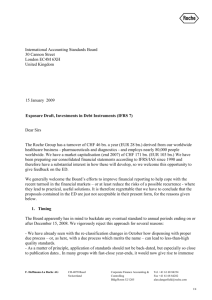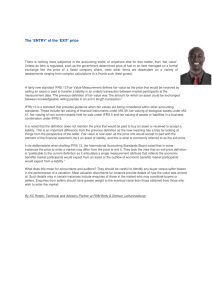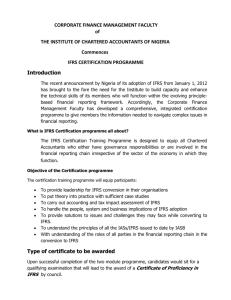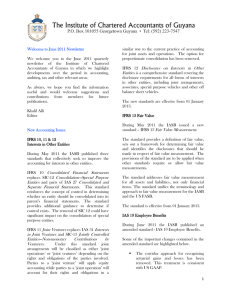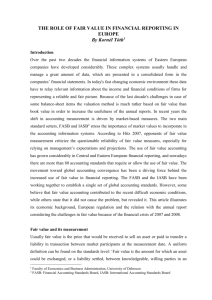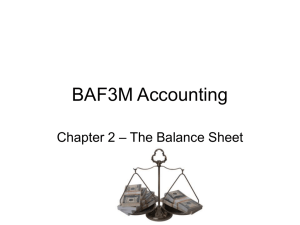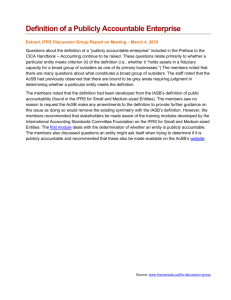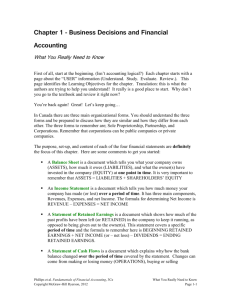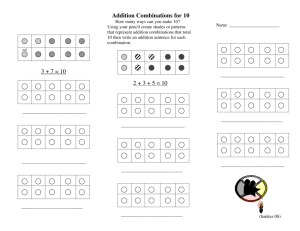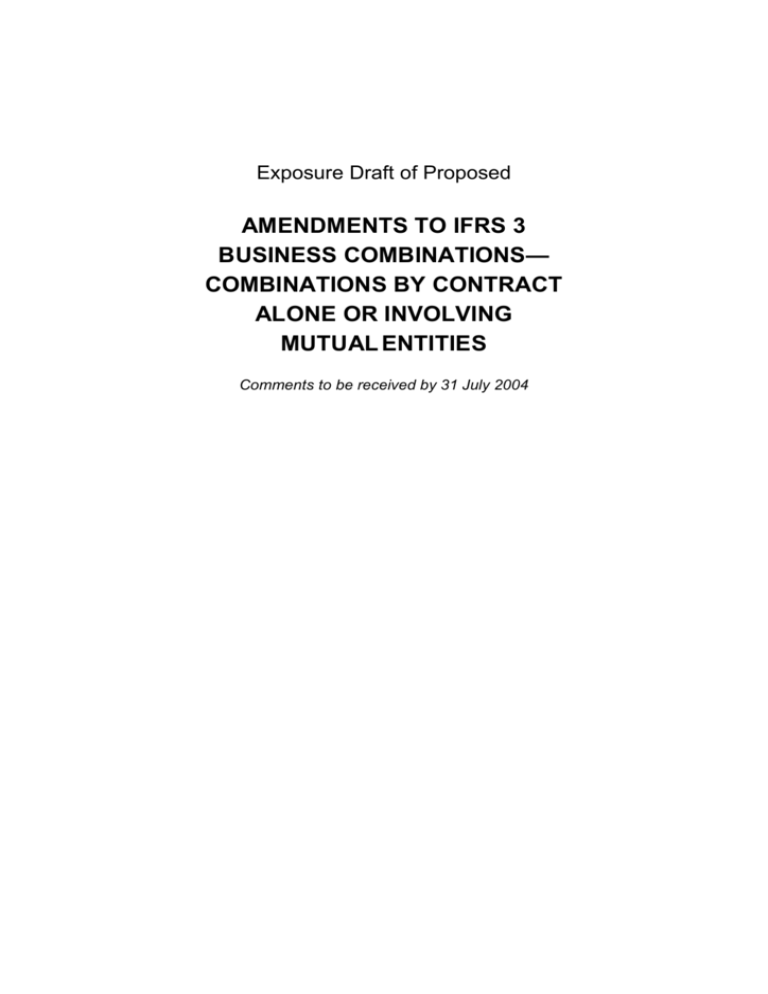
Exposure Draft of Proposed
AMENDMENTS TO IFRS 3
BUSINESS COMBINATIONS—
COMBINATIONS BY CONTRACT
ALONE OR INVOLVING
MUTUAL ENTITIES
Comments to be received by 31 July 2004
PROPOSED AMENDMENTS TO IFRS 3 BUSINESS COMBINATIONS APRIL 2004
This Exposure Draft of proposed Amendments to IFRS 3 Business Combinations
is published by the International Accounting Standards Board (IASB) for comment
only. The proposals may be modified in the light of the comments received before
being issued in the form of amendments to an International Financial Reporting
Standard (IFRS). Comments on the Exposure Draft should be submitted in writing
so as to be received by 31 July 2004.
All responses will be put on the public record unless the respondent requests
confidentiality. However, such requests will not normally be granted unless
supported by good reason, such as commercial confidence. If commentators
respond by fax or email, it would be helpful if they could also send a hard copy of
their response by post. Comments should preferably be sent by email to:
CommentLetters@iasb.org or addressed to:
Annette Kimmit
Senior Project Manager
International Accounting Standards Board
30 Cannon Street, London EC4M 6XH, United Kingdom
Fax: +44 (0)20 7246 6411
The IASB, the IASCF, the authors and the publishers do not accept responsibility
for loss caused to any person who acts or refrains from acting in reliance on the
material in this publication, whether such loss is caused by negligence or
otherwise.
Copyright © 2004 International Accounting Standards Committee Foundation
(IASCF)
ISBN: 1-904230-62-8
All rights reserved. Copies of the draft Amendments and the accompanying
documents may be made for the purpose of preparing comments to be submitted
to the IASB, provided such copies are for personal or intraorganisational use only
and are not sold or disseminated and provided each copy acknowledges the
International Accounting Standards Committee Foundation’s copyright and sets
out the IASB’s address in full. Otherwise, no part of this publication may be
translated, reprinted or reproduced or utilised in any form either in whole or in part
or by any electronic, mechanical or other means, now known or hereafter invented,
including photocopying and recording, or in any information storage and retrieval
system, without prior permission in writing from the International Accounting
Standards Committee Foundation.
The IASB logo/“Hexagon Device”, “eIFRS”, “IAS”, “IASB”, “IASC”, “IASCF”, “IASs”,
“IFRIC”, “IFRS”, “IFRSs”, “International Accounting Standards”, “International
Financial Reporting Standards” and “SIC” are Trade Marks of the International
Accounting Standards Committee Foundation.
Additional copies of this publication may be obtained from:
IASCF Publications Department,
1st Floor, 30 Cannon Street, London EC4M 6XH, United
Kingdom.
Tel: +44 (0)20 7332 2730 Fax: +44 (0)20 7332 2749
Email: publications@iasb.org Web: www.iasb.org
© Copyright IASCF
2
CONTENTS
Contents
pages
BACKGROUND
4-6
INVITATION TO COMMENT
7-8
PROPOSED AMENDMENTS TO IFRS 3
BASIS FOR CONCLUSIONS
9-13
14-20
ALTERNATIVE VIEW
21
3
© Copyright IASCF
PROPOSED AMENDMENTS TO IFRS 3 BUSINESS COMBINATIONS APRIL 2004
BACKGROUND
1
The International Accounting Standards Board announced in July 2001
that it would undertake a project on business combinations as part of
its initial agenda. The project has a number of phases. The first phase
resulted in the Board issuing in March 2004 IFRS 3 Business
Combinations and revised versions of IAS 36 Impairment of Assets
and IAS 38 Intangible Assets. IFRS 3 superseded IAS 22 Business
Combinations (as issued in 1998). The subsequent phases will involve
consideration of, amongst other things, the application of the purchase
method to the accounting for business combinations.
2
IFRS 3 requires all business combinations to be accounted for by
applying the purchase method. However, IFRS 3 excludes from its
scope specified types of business combinations, including:
(a)
combinations involving two or more mutual entities.
(b)
combinations in which separate entities are brought together to
form a reporting entity by contract alone without the obtaining of
an ownership interest. This includes combinations in which
separate entities are brought together by contract to form a dual
listed corporation.
In developing IFRS 3, the Board observed that differences between the
ownership structures of mutual entities and those of investor-owned
entities give rise to complications in applying the purchase method to
business combinations involving two or more mutual entities. Such
transactions normally do not involve the payment of any reliably
measurable consideration. Thus, difficulties arise in estimating the
cost of the business combination and any goodwill acquired in the
combination. Similar complications arise in applying the purchase
method to combinations involving the formation of a reporting entity by
contract alone without the obtaining of an ownership interest.
3
IFRS 3 was preceded in December 2002 by the Exposure Draft ED 3
Business Combinations. ED 3 proposed that entities should continue
to apply IAS 22 to the accounting for such transactions until the Board
develops, as part of the subsequent phase of its Business
Combinations project, guidance on the application of the purchase
method to those transactions.
© Copyright IASCF
4
CONTENTS
4
During its redeliberations, the Board observed that continuing to apply
IAS 22 to such transactions was not a satisfactory solution. Instead,
the Board decided that until it develops, as part of a subsequent phase
of its Business Combinations project, guidance on applying the
purchase method to such transactions, IFRS 3:
(a)
should include such transactions within its scope.
(b)
should require the acquirer to measure the cost of such a
combination as:
(i)
the net fair value of the acquiree’s identifiable assets,
liabilities and contingent liabilities when the combination is
one in which separate entities or businesses are brought
together to form a reporting entity by contract alone without
the obtaining of an ownership interest.
(ii)
the aggregate of the following amounts when the
combination is one in which the acquirer and acquiree are
both mutual entities:
•
the net fair value of the acquiree’s identifiable assets,
liabilities and contingent liabilities; and
•
the fair value, at the date of exchange, of any assets
given, liabilities incurred or assumed, or equity
instruments issued by the acquirer in exchange for
control of the acquiree.
Therefore, until guidance on applying the purchase method
to such transactions is developed, the acquirer would
recognise goodwill equal to the fair value, at the date of
exchange, of any consideration given by the acquirer in
exchange for control of the acquiree.
5
The Board decided, however, that it would not be appropriate to
incorporate this interim solution into IFRS 3 without first exposing it for
public comment—hence, the publication of this Exposure Draft.
5
© Copyright IASCF
PROPOSED AMENDMENTS TO IFRS 3 BUSINESS COMBINATIONS APRIL 2004
Transitional provisions and effective date
6
The Exposure Draft proposes that no amendments should be made to
the transitional and effective date requirements in IFRS 3. For ease of
reference, those requirements are reproduced on pages 10-13 of this
Exposure Draft. This would mean that:
(a)
entities would not be required to apply the revised version of IFRS
3 arising from this Exposure Draft to the accounting for any
business combinations for which the agreement date is before 31
March 2004. This would include combinations in which the
acquirer and acquiree are both mutual entities or in which
separate entities or businesses are brought together to form a
reporting entity by contract alone without the obtaining of an
ownership interest.
(b)
entities would be permitted to apply the revised version of IFRS 3
arising from this Exposure Draft from any date before 31 March
2004, provided:
(i)
the valuations and other information needed to apply the
IFRS to past business combinations were obtained at the
time those combinations were initially accounted for; and
(ii)
the entity also applies IAS 36 and IAS 38 (both as revised in
2004) prospectively from that same date, and the valuations
and other information needed to apply those Standards from
that date were previously obtained by the entity so that there
is no need to determine estimates that would need to have
been made at a prior date.
Therefore, entities that elect to apply the revised version of IFRS
3 from any date before 31 March 2004 would be required to apply
that revised version to any combination in which the acquirer and
acquiree are both mutual entities or in which separate entities or
businesses are brought together to form a reporting entity by
contract alone without the obtaining of an ownership interest, and
for which the agreement date is after the date selected but before
31 March 2004.
(c)
entities would be required to apply the revised version of IFRS 3
arising from this Exposure Draft to the accounting for all business
© Copyright IASCF
6
CONTENTS
combinations for which the agreement date is 31 March 2004 or
later, including combinations addressed by this Exposure Draft.
7
© Copyright IASCF
PROPOSED AMENDMENTS TO IFRS 3 BUSINESS COMBINATIONS APRIL 2004
INVITATION TO COMMENT
The International Accounting Standards Board invites comments on the
amendments to IFRS 3 proposed in this Exposure Draft. It would particularly
welcome answers to the questions below. Comments are most helpful if they
indicate the specific paragraph or group of paragraphs to which they relate,
contain a clear rationale and, when applicable, provide a suggestion for
alternative wording.
The Board is not requesting comments on matters in IFRS 3 other than those
set out in this Exposure Draft.
Comments should be submitted in writing so as to be received no later than
31 July 2004.
Question 1
The Exposure Draft proposes:
(a)
to remove from IFRS 3 the scope exclusions for business combinations
involving two or more mutual entities and business combinations in
which separate entities are brought together to form a reporting entity
by contract alone without the obtaining of an ownership interest.
(b)
to require the acquirer to measure the cost of a business combination
as:
(i)
the aggregate of the following amounts when the combination is
one in which the acquirer and acquiree are both mutual entities:
•
the net fair value of the acquiree’s identifiable assets,
liabilities and contingent liabilities; and
•
the fair value, at the date of exchange, of any assets given,
liabilities incurred or assumed, or equity instruments issued
by the acquirer in exchange for control of the acquiree.
Therefore, goodwill would be recognised in the accounting for
such transactions only to the extent of any consideration given by
the acquirer in exchange for control of the acquiree.
© Copyright IASCF
8
CONTENTS
(ii)
the net fair value of the acquiree’s identifiable assets, liabilities
and contingent liabilities when the combination is one in which
separate entities or businesses are brought together to form a
reporting entity by contract alone without the obtaining of an
ownership interest. Therefore, no goodwill would arise in the
accounting for such transactions.
Is this an appropriate interim solution to the accounting for such transactions
until the Board develops guidance on applying the purchase method to such
transactions as part of a subsequent phase of its Business Combinations
project? If not, what other approach would you recommend as an interim
solution to the accounting for such transactions, and why?
Question 2
The Exposure Draft proposes that no amendments be made to the transitional
and effective date requirements in IFRS 3. This would have the effects set
out in paragraph 6(a)-(c) above on the accounting for business combinations
in which the acquirer and acquiree are both mutual entities or in which
separate entities or businesses are brought together to form a reporting entity
by contract alone without the obtaining of an ownership interest.
Is this appropriate? If not, what transitional and effective date arrangements
would you recommend for such business combinations, and why?
9
© Copyright IASCF
PROPOSED AMENDMENTS TO IFRS 3 BUSINESS COMBINATIONS APRIL 2004
PROPOSED AMENDMENTS TO IFRS 3
BUSINESS COMBINATIONS
Proposed amendments are shown as marked changes to IFRS 3. New text is
underlined and deleted text is struck through.
In the Scope section, subparagraphs 3(c) and 3(d) are deleted. Therefore,
paragraph 3 will read as follows.
3
This IFRS does not apply to:
(a)
business combinations in which separate entities or businesses
are brought together to form a joint venture.
(b)
business combinations involving entities or businesses under
common control.
(c)
business combinations involving two or more mutual entities.
(d)
business combinations in which separate entities or businesses
are brought together to form a reporting entity by contract alone
without the obtaining of an ownership interest (for example,
combinations in which separate entities are brought together by
contract alone to form a dual listed corporation).
In the section “Cost of a business combination”, paragraph 24 is amended to
read as follows and paragraphs 31A and 31B are added.
24
Except as provided in paragraph 31A, Tthe acquirer shall measure
the cost of a business combination as the aggregate of:
(a)
the fair values, at the date of exchange, of assets given,
liabilities incurred or assumed, and equity instruments
issued by the acquirer, in exchange for control of the
acquiree; plus
(b)
any costs directly attributable to the business combination.
© Copyright IASCF
10
CONTENTS
31A
The acquirer shall measure the cost of a business combination:
(a)
(b)
31B
as the aggregate of the following amounts when the combination
is one in which the acquirer and acquiree are both mutual entities:
(i)
the net fair value of the acquiree’s identifiable assets,
liabilities and contingent liabilities recognised in accordance
with paragraph 37; and
(ii)
the fair value, at the date of exchange, of any assets given,
liabilities incurred or assumed, or equity instruments issued
by the acquirer in exchange for control of the acquiree.
as the net fair value of the acquiree’s identifiable assets, liabilities
and contingent liabilities recognised in accordance with paragraph
37 when the combination is one in which separate entities or
businesses are brought together to form a reporting entity by
contract alone without the obtaining of an ownership interest (for
example, combinations in which separate entities are brought
together by contract alone to form a dual listed corporation).
The cost of a business combination measured in accordance with
paragraph 31A shall exclude any costs directly attributable to the
combination, such as professional fees paid to accountants, legal
advisers, valuers and other consultants to effect the combination. Such
costs shall be recognised as an expense in profit or loss in the period in
which they are incurred.
In the section “TRANSITIONAL PROVISIONS AND EFFECTIVE DATE”,
paragraphs 78-85 are not amended. For ease of reference, those
paragraphs are reproduced below.
78
Except as provided in paragraph 85, this IFRS shall apply to the
accounting for business combinations for which the agreement date is
on or after 31 March 2004. This IFRS shall also apply to the
accounting for:
(a)
goodwill arising from a business combination for which the
agreement date is on or after 31 March 2004; or
(b)
any excess of the acquirer’s interest in the net fair value of the
acquiree’s identifiable assets, liabilities and contingent liabilities
11
© Copyright IASCF
PROPOSED AMENDMENTS TO IFRS 3 BUSINESS COMBINATIONS APRIL 2004
over the cost of a business combination for which the agreement
date is on or after 31 March 2004.
Previously recognised goodwill
79
80
An entity shall apply this IFRS prospectively, from the beginning of the
first annual period beginning on or after 31 March 2004, to goodwill
acquired in a business combination for which the agreement date was
before 31 March 2004, and to goodwill arising from an interest in a
jointly controlled entity obtained before 31 March 2004 and accounted
for by applying proportionate consolidation. Therefore, an entity shall:
(a)
from the beginning of the first annual period beginning on or after
31 March 2004, discontinue amortising such goodwill;
(b)
at the beginning of the first annual period beginning on or after
31 March 2004, eliminate the carrying amount of the related
accumulated amortisation with a corresponding decrease in
goodwill; and
(c)
from the beginning of the first annual period beginning on or after
31 March 2004, test the goodwill for impairment in accordance
with IAS 36 (as revised in 2004).
If an entity previously recognised goodwill as a deduction from equity, it
shall not recognise that goodwill in profit or loss when it disposes of all
or part of the business to which that goodwill relates or when a
cashgenerating unit to which the goodwill relates becomes impaired.
Previously recognised negative goodwill
81
The carrying amount of negative goodwill at the beginning of the first
annual period beginning on or after 31 March 2004 that arose from
either
(a)
a business combination for which the agreement date was before
31 March 2004 or
(b)
an interest in a jointly controlled entity obtained before 31 March
2004 and accounted for by applying proportionate consolidation
© Copyright IASCF
12
CONTENTS
shall be derecognised at the beginning of that period, with a
corresponding adjustment to the opening balance of retained earnings.
Previously recognised intangible assets
82
The carrying amount of an item classified as an intangible asset that
either
(a)
was acquired in a business combination for which the agreement
date was before 31 March 2004 or
(b)
arises from an interest in a jointly controlled entity obtained before
31 March 2004 and accounted for by applying proportionate
consolidation
shall be reclassified as goodwill at the beginning of the first annual
period beginning on or after 31 March 2004, if that intangible asset
does not at that date meet the identifiability criterion in IAS 38 (as
revised in 2004).
Equity accounted investments
83
84
For investments accounted for by applying the equity method and
acquired on or after 31 March 2004, an entity shall apply this IFRS in
the accounting for:
(a)
any acquired goodwill included in the carrying amount of that
investment. Therefore, amortisation of that notional goodwill shall
not be included in the determination of the entity’s share of the
investee’s profits or losses.
(b)
any excess included in the carrying amount of the investment of
the entity’s interest in the net fair value of the investee’s
identifiable assets, liabilities and contingent liabilities over the cost
of the investment. Therefore, an entity shall include that excess
as income in the determination of the entity’s share of the
investee’s profits or losses in the period in which the investment is
acquired.
For investments accounted for by applying the equity method and
acquired before 31 March 2004:
13
© Copyright IASCF
PROPOSED AMENDMENTS TO IFRS 3 BUSINESS COMBINATIONS APRIL 2004
(a)
an entity shall apply this IFRS on a prospective basis, from the
beginning of the first annual period beginning on or after 31
March 2004, to any acquired goodwill included in the carrying
amount of that investment. Therefore, an entity shall, from that
date, discontinue including the amortisation of that goodwill in the
determination of the entity’s share of the investee’s profits or
losses.
(b)
an entity shall derecognise any negative goodwill included in the
carrying amount of that investment at the beginning of the first
annual period beginning on or after 31 March 2004, with a
corresponding adjustment to the opening balance of retained
earnings.
Limited retrospective application
85
An entity is permitted to apply the requirements of this IFRS to goodwill
existing at or acquired after, and to business combinations occurring
from, any date before the effective dates outlined in paragraphs 78-84,
provided:
(a)
the valuations and other information needed to apply the IFRS to
past business combinations were obtained at the time those
combinations were initially accounted for; and
(b)
the entity also applies IAS 36 (as revised in 2004) and IAS 38 (as
revised in 2004) prospectively from that same date, and the
valuations and other information needed to apply those Standards
from that date were previously obtained by the entity so that there
is no need to determine estimates that would need to have been
made at a prior date.
© Copyright IASCF
14
CONTENTS
BASIS FOR CONCLUSIONS
This Basis for Conclusions accompanies, but is not part of, the proposed
amendments to IFRS 3.
Introduction
BC1
This Basis for Conclusions summarises the International Accounting
Standards Board’s considerations in reaching its conclusions on the
proposed amendments to IFRS 3 Business Combinations. Individual
Board members gave greater weight to some factors than to others.
BC2
IFRS 3 was issued by the Board in March 2004 as part of the first
phase of its project on business combinations. IFRS 3 superseded
IAS 22 Business Combinations (as issued in 1998). The subsequent
phases of the project will involve consideration of:
BC3
(a)
issues related to the application of the purchase method to the
accounting for business combinations.
(b)
the accounting for business combinations in which separate
entities or businesses are brought together to form a joint venture,
including possible applications for ‘fresh start’ accounting.
(c)
the accounting for business combinations involving entities under
common control.
This Exposure Draft addresses an issue that the Board identified
during its redeliberations of the proposals in the December 2002
Exposure Draft ED 3 Business Combinations, the Exposure Draft that
preceded IFRS 3. The Board concluded that it could not resolve this
issue without first exposing its proposed solution for public comment.
The issue stems from the proposal in ED 3 to delay the application of
IFRS 3 to the accounting for the following combinations, until the Board
issues guidance on the application of the purchase method to those
combinations:
(a)
involving two or more mutual entities.
15
© Copyright IASCF
PROPOSED AMENDMENTS TO IFRS 3 BUSINESS COMBINATIONS APRIL 2004
(b)
in which separate entities are brought together to form a reporting
entity by contract alone without the obtaining of an ownership
interest (eg combinations in which separate entities are brought
together by contract to form a dual listed corporation).
Combinations involving mutual entities or the
bringing together of separate entities to form a
reporting entity by contract alone
BC4
IFRS 3 requires all business combinations to be accounted for by
applying the purchase method. However, IFRS 3 excludes from its
scope specified types of business combinations, including:
(a)
combinations involving two or more mutual entities.
(b)
combinations in which separate entities are brought together to
form a reporting entity by contract alone without the obtaining of
an ownership interest. This includes combinations in which
separate entities are brought together by contract to form a dual
listed corporation.
BC5
ED 3 did not propose to exclude such transactions from the scope of
the IFRS, but instead proposed to delay its application to the
accounting for such transactions. In developing ED 3, the Board
observed that differences between the ownership structures of mutual
entities (such as mutual insurance companies or mutual cooperative
entities) and those of investor-owned entities give rise to complications
in applying the purchase method to business combinations involving
two or more mutual entities.
Similarly, the Board noted that
complications arise in applying the purchase method to combinations
involving the formation of a reporting entity by contract alone without
the obtaining of an ownership interest. The Board decided to propose
in ED 3 that until those issues are resolved as part of the second
phase of the Business Combinations project, IAS 22 should continue to
apply to the accounting for such transactions.
BC6
During its redeliberations, the Board observed that continuing to apply
IAS 22 to such transactions would result in them being classified either
as unitings of interests or as acquisitions. If such a transaction were
classified as a uniting of interests, IAS 22 would require it to be
accounted for by applying the pooling of interests method. The Board
decided that this would not be consistent with its conclusion, as set out
© Copyright IASCF
16
CONTENTS
in paragraphs BC50-BC53 of the Basis for Conclusions on IFRS 3, that
there are no circumstances in which the pooling of interests method
provides information superior to that provided by the purchase method.
The Board also observed that if such a transaction were classified as
an acquisition, IAS 22 would require it to be accounted for by applying
the purchase method, but a version of the purchase method different
from that now contained in IFRS 3. The Board found it troublesome
that two versions of the purchase method might co-exist for a period of
time, particularly given that the two versions produce different results.
For example, unlike IFRS 3, IAS 22 would require goodwill
amortisation and permit restructuring plans that do not meet the
definition of a liability to be recognised as a provision as part of
allocating the cost of the combination.
BC7
The Board then considered whether entities should be required to
apply IFRS 3 to such transactions, focusing its discussion on two
issues that might arise in applying the purchase method to those
transactions. The first was the proposition that it might be difficult to
identify the acquirer.
The second was the concern that such
transactions normally do not involve the payment of any reliably
measurable consideration. Thus, difficulties would arise in estimating
the cost of the business combination and any goodwill acquired in the
combination.
BC8
On the first issue, the Board reaffirmed its conclusion, set out in
paragraphs BC54 and BC55 of the Basis for Conclusions on IFRS 3,
that although domestic legal, taxation or economic factors can
sometimes make it difficult to identify an acquirer, no exceptions to
applying the purchase method should be permitted. The pooling of
interests method does not, in any circumstances, provide information
superior to that provided by the purchase method, even if identifying
the acquirer is problematic.
BC9
On the second issue, the Board decided that until it develops, as part
of a subsequent phase of its Business Combinations project, guidance
on applying the purchase method to such transactions, they should
continue to be within the scope of IFRS 3. However, IFRS 3 should
require the total of the net fair value of the acquiree’s identifiable
assets, liabilities and contingent liabilities and any reliably measurable
consideration given in exchange for control of the acquiree to be
treated as the deemed cost of the business combination. Therefore,
until guidance is developed on applying the purchase method to such
combinations, goodwill would arise in the accounting for them only to
the extent of any reliably measurable consideration given by the
acquirer in exchange for control of the acquiree. The Board concluded
17
© Copyright IASCF
PROPOSED AMENDMENTS TO IFRS 3 BUSINESS COMBINATIONS APRIL 2004
that this measure of deemed cost results, for all such transactions, in
the appropriate recognition of the acquiree’s identifiable assets,
liabilities and contingent liabilities at their fair values at the acquisition
date, consistently with the Board’s conclusions in IFRS 3. At the same
time, it does not involve the difficulties identified in paragraph BC7 in
estimating the cost of the combination and any resultant goodwill.
As such, it is an improvement on the proposal in ED 3 to continue the
application of IAS 22 to the accounting for such transactions.
BC10 The Board decided, however, that it would not be appropriate to
incorporate this interim solution into IFRS 3 without first exposing it for
public comment. Therefore, given the Board’s desire to issue IFRS 3
before the end of March 2004, the Board decided:
(a)
to proceed with issuing IFRS 3 in March 2004, but to exclude
such transactions from its scope.
(b)
to publish the Exposure Draft to propose a limited amendment to
IFRS 3 whereby such transactions would be within the scope of
IFRS 3, but with the cost of the combination deemed to be equal
to:
(i)
(ii)
© Copyright IASCF
the aggregate of the following amounts when the
combination is one in which the acquirer and acquiree are
both mutual entities:
•
the net fair value of the acquiree’s identifiable assets,
liabilities and contingent liabilities recognised in
accordance with paragraph 37 of IFRS 3; and
•
the fair value, at the date of exchange, of any assets
given, liabilities incurred or assumed, or equity
instruments issued by the acquirer in exchange for
control of the acquiree.
the net fair value of the acquiree’s identifiable assets,
liabilities and contingent liabilities recognised in accordance
with paragraph 37 of IFRS 3 when the combination is one in
which separate entities or businesses are brought together
to form a reporting entity by contract alone without the
obtaining of an ownership interest.
18
CONTENTS
Transitional provisions and effective date
BC11 The Exposure Draft proposes that no amendments should be made to
the transitional and effective date requirements in IFRS 3. This would
have the effects set out in paragraph 6(a)-(c) of the Background
section of the Exposure Draft on the accounting for business
combinations in which the acquirer and acquiree are both mutual
entities or in which separate entities or businesses are brought
together to form a reporting entity by contract alone without the
obtaining of an ownership interest.
Business combinations for which the agreement date is
before 31 March 2004
BC12 In accordance with IFRS 3, an entity is required to apply that Standard
to business combinations for which the agreement date is on or after
31 March 2004 (the date that IFRS 3 was issued). However, an entity
is permitted to apply IFRS 3 from any date before 31 March 2004,
provided:
(a)
the valuations and other information needed to apply that
Standard to the past business combinations were obtained at the
time those combinations were initially accounted for; and
(b)
the entity also applies IAS 36 Impairment of Assets (as revised in
2004) and IAS 38 Intangible Assets (as revised in 2004)
prospectively from that same date, and the valuations and other
information needed to apply those Standards from that date were
previously obtained by the entity so that there is no need to
determine estimates that would need to have been made at a
prior date.
IFRS 3 refers to this as permitting ‘limited retrospective application’.
BC13 Paragraphs BC180 and BC183 of the Basis for Conclusions on IFRS 3
set out the Board’s deliberations in developing these requirements:
BC180
The Board observed that requiring the IFRS to be applied
retrospectively to all business combinations for which the agreement
date is before the date the IFRS was issued might improve the
comparability of financial information. However, such an approach
would be problematic for the following reasons:
19
© Copyright IASCF
PROPOSED AMENDMENTS TO IFRS 3 BUSINESS COMBINATIONS APRIL 2004
(a)
it is likely to be impossible for many business combinations
because the information needed may not exist or may no
longer be obtainable.
(b)
it requires the determination of estimates that would have
been made at a prior date, and therefore raises problems in
relation to the role of hindsight—in particular, whether the
benefit of hindsight should be included or excluded from those
estimates and, if excluded, how the effect of hindsight can be
separated from the other factors existing at the date for which
the estimates are required.
The Board concluded that the problems associated with applying the
IFRS retrospectively, on balance, outweigh the benefit of improved
comparability of financial information.
BC183
The Board noted that giving entities the option of applying the IFRS to
past business combinations from any date before the IFRS’s effective
dates would impair the comparability of financial information.
However, the Board also noted that the issue of any new or revised
IFRS reflects its opinion that application of that IFRS will result in
more useful information being provided to users about an entity’s
financial position, performance or cash flows. On that basis, a case
exists for permitting, and indeed encouraging, entities to apply a new
or revised IFRS before its effective date. The Board concluded that if
it were practicable for an entity to apply the IFRS from any date before
the IFRS’s effective dates, users of the entity’s financial statements
would be provided with more useful information than was previously
the case under IAS 22. The Board concluded that the benefit of
providing users with more useful information about an entity’s financial
position and performance by allowing limited retrospective application
of this IFRS outweighs the disadvantages of potentially diminished
comparability.
BC14 Consistently with its conclusion set out in paragraph BC180 of the
Basis for Conclusions on IFRS 3, the Board concluded that the
problems associated with requiring the revised version of IFRS 3
arising from this Exposure Draft to be applied to the accounting for
business combinations for which the agreement date is before 31
March 2004 would, on balance, outweigh the benefit of improved
comparability. Therefore, an entity should not be required to apply the
revised version of IFRS 3 to combinations for which the agreement
date is before 31 March 2004 and that involve two or more mutual
entities or the bringing together of separate entities to form a reporting
entity by contract alone without the obtaining of an ownership interest.
BC15 However, consistently with its conclusion set out in paragraph BC183
of the Basis for Conclusions on IFRS 3, the Board decided that the
© Copyright IASCF
20
CONTENTS
Exposure Draft should not propose to exclude such combinations from
the limited retrospective application option in IFRS 3.
Business combinations for which the agreement date is
31 March 2004 or later
BC16 The Board observed that the arguments set out in paragraph BC180 of
the Basis for Conclusions on IFRS 3 against requiring restatement of
past business combinations will not hold for combinations that involve
two or more mutual entities or the bringing together of separate entities
to form a reporting entity by contract alone without the obtaining of an
ownership interest, and for which the agreement date is on or after 31
March 2004 but before the date the revised version of IFRS 3 is
issued. This is because the Board intends to finalise the amendments
to IFRS 3 before the end of 2004, meaning that the period during which
such combinations will be excluded from the scope of IFRS 3 should
be relatively short. As a result:
(a)
the information needed to restate such combinations should be
obtainable, notwithstanding that it might not have been obtained
at the time of initially accounting for the combination.
(b)
any problems in relation to the role of hindsight should not be
insurmountable given the relatively short period between the
possible agreement date of such a combination and the date the
amendments to IFRS 3 are to be finalised.
BC17 Additionally:
(a)
because such combinations are excluded from the scope of IFRS
3 and entities therefore have the option of accounting for the
combinations using any method they choose, the restatement of
those combinations by applying the proposals in this Exposure
Draft would lead to improved comparability of financial
information.
(b)
the issue of any new or revised IFRS reflects the Board’s opinion
that application of that IFRS will result in more useful information
being provided to users about an entity’s financial position,
performance or cash flows. On that basis, a case exists for
requiring entities to restate such combinations by applying the
proposals in this Exposure Draft.
21
© Copyright IASCF
PROPOSED AMENDMENTS TO IFRS 3 BUSINESS COMBINATIONS APRIL 2004
Therefore, the Board concluded that entities should be required to
apply the revised version of IFRS 3 arising from this Exposure Draft to
the accounting for combinations that involve two or more mutual
entities or the bringing together of separate entities to form a reporting
entity by contract alone without the obtaining of an ownership interest,
and for which the agreement date is on or after 31 March 2004 but
before the date the revised version of IFRS 3 is issued.
© Copyright IASCF
22
CONTENTS
ALTERNATIVE VIEW
AV1
One Board member voted against the publication of the Exposure Draft
of Proposed Amendments to IFRS 3 Business Combinations. The
Board member believes that combinations involving two or more
mutual entities and those in which separate entities or businesses are
brought together to form a reporting entity by contract alone (as
described in paragraph BC4) should continue to be excluded from the
scope of IFRS 3, pending completion of the Board’s promised work on
the ‘fresh start’ method of accounting.
AV2
The Board member is of the view that the combinations described in
paragraph BC4 do not always fit easily into the modified purchase
method of accounting proposed in the Exposure Draft, particularly
because there may not be a readily identifiable acquirer. Therefore,
they may be more appropriately accounted for by applying the fresh
start method, which the Board has committed itself to investigating as
part of its Business Combinations project (see paragraph BC49 of the
Basis for Conclusions on IFRS 3). In the meantime, requiring the
replacement of one unsatisfactory method (the pooling of interests
method) with another (a modified version of the purchase method) is
not, in the Board member’s view, an improvement. Moreover, the
mistaken belief that the enforcement of a modified purchase method
will provide a satisfactory solution may lead to the fresh start method
not being accorded the urgent attention that it deserves.
23
© Copyright IASCF

